Out of Ngorongoro and into the Serengeti
We left early the next morning (recording yet another superb sunrise that was invisible directly but only reflected in the lake in the crater bed)…
(The oval outline is the lake at the bottom of the crater; the vegetation is actually on an incline that slopes down to the bottom of the caldera. The mauve area is the area of the crater rim across from where I am…it’s lost in mist. I still cannot understand how, when the sunrise was not visible it was so brightly reflected in the lake. I am googling about this but have got no results.)
As we left the crater rim, we drove down into the grasslands, and passed a Masai village (the Masai cannot live in the Serengeti where no “human activity” apart from wildlifing is allowed; they live in the NCA.)
 As we came down, I was treated to another mother-and-child scene, of AFRICAN ELEPHANTS this time...
As we came down, I was treated to another mother-and-child scene, of AFRICAN ELEPHANTS this time...
 And we passed what Huruma called the "V-point" which was a place to take a last look at the Ngorongoro Conservation Area:
And we passed what Huruma called the "V-point" which was a place to take a last look at the Ngorongoro Conservation Area:
 Here's a snap of the mountains receding as we moved into the plains...
Here's a snap of the mountains receding as we moved into the plains...
 The landscape that I always have associtated with the Serengeti started appearing....
The landscape that I always have associtated with the Serengeti started appearing....
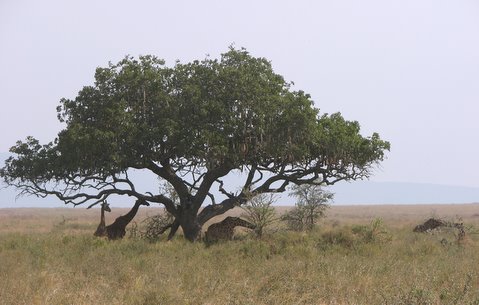 Those GIRAFFES are under a SAUSAGE TREE, which we have plenty of in Bangalore as well! But soon the FLAT-TOP ACACIAS started appearing.
The name, Serengeti, apparently means, vast or unlimited space, which is how it must have struck the men as they came down from the mountains. It is incredible to see the vast plain, open with just grass and a few trees here and there...and see all the animals there together! We have this rooted concept of the herbivores hiding from the carnivores..it was amazing that except for the time of the hunt, they apparently live quite well together!
Here's a baby giraffe (yes, I do like to photographs babies with their mothers, but this one's mother was not close by). S/he (they do look all like she's with those outsize eyelashes!) looked for all the world like one of the stuffed toys one can get in the souvenir shops, and so cute did she look that we were (almost) tempted to pat her on the back!
Those GIRAFFES are under a SAUSAGE TREE, which we have plenty of in Bangalore as well! But soon the FLAT-TOP ACACIAS started appearing.
The name, Serengeti, apparently means, vast or unlimited space, which is how it must have struck the men as they came down from the mountains. It is incredible to see the vast plain, open with just grass and a few trees here and there...and see all the animals there together! We have this rooted concept of the herbivores hiding from the carnivores..it was amazing that except for the time of the hunt, they apparently live quite well together!
Here's a baby giraffe (yes, I do like to photographs babies with their mothers, but this one's mother was not close by). S/he (they do look all like she's with those outsize eyelashes!) looked for all the world like one of the stuffed toys one can get in the souvenir shops, and so cute did she look that we were (almost) tempted to pat her on the back!
 We passed these WHISTLING THORN ACACIAS and Huruma told us a very interesting fact about them:
We passed these WHISTLING THORN ACACIAS and Huruma told us a very interesting fact about them:
 There is a symbiotic relationship between the ants of the species Cremogaster and these plants,
In spite of their awful-looking thorns, giraffes still eat up these acacias...but when the ants build these round nests around the thorns
There is a symbiotic relationship between the ants of the species Cremogaster and these plants,
In spite of their awful-looking thorns, giraffes still eat up these acacias...but when the ants build these round nests around the thorns
 (you can see the hole which the ants use as an entrance), giraffes which eat the plants get a mouthful of stinging ants as well, and therefore refrain from eating up the plants. There is a theory, though, that not all the ants' nests are beneficial...but the important fact is that when the wind blows over these holes, it makes a whistling noise in the acacias! Amazing....! This particular plant had Crematogaster nigriceps ants...
And in the picture, if you look carefully, you can see me taking the picture, in the rear-view mirror!
We also saw how cleverly some of the WEAVERS had made nests even amongst those wicked thorns...
(you can see the hole which the ants use as an entrance), giraffes which eat the plants get a mouthful of stinging ants as well, and therefore refrain from eating up the plants. There is a theory, though, that not all the ants' nests are beneficial...but the important fact is that when the wind blows over these holes, it makes a whistling noise in the acacias! Amazing....! This particular plant had Crematogaster nigriceps ants...
And in the picture, if you look carefully, you can see me taking the picture, in the rear-view mirror!
We also saw how cleverly some of the WEAVERS had made nests even amongst those wicked thorns...
 We went on, spotting a variety of creatures like
the BLACK-BELLIED BUSTARD
We went on, spotting a variety of creatures like
the BLACK-BELLIED BUSTARD
 and the AFRICAN BUFFALO
and the AFRICAN BUFFALO
 which look rather similar to their Indian (Asian) counterparts...
(See my post, I just made up a limerick about the buffalo!)
Shortly thereafter, we saw a pyramid. We *knew* there were pyramids in Africa, but we had rather thought they were in Egypt! But this was just to mark the entrance into the Serengeti National Park!
which look rather similar to their Indian (Asian) counterparts...
(See my post, I just made up a limerick about the buffalo!)
Shortly thereafter, we saw a pyramid. We *knew* there were pyramids in Africa, but we had rather thought they were in Egypt! But this was just to mark the entrance into the Serengeti National Park!
 We carefully read the rules...
We carefully read the rules...
 I was very tickled by the words "Offroad is Strictly Prohibited" being immediately followed by the words "Offroads under Permission"!
And we looked at the fees...oh my, the Serengeti is NOT a cheap place! It explains why, in a poor country like Tanzania (poorer than India I think), no locals come to look at the fantastic wildlife they have...which is sad.
I was very tickled by the words "Offroad is Strictly Prohibited" being immediately followed by the words "Offroads under Permission"!
And we looked at the fees...oh my, the Serengeti is NOT a cheap place! It explains why, in a poor country like Tanzania (poorer than India I think), no locals come to look at the fantastic wildlife they have...which is sad.
 We stopped for a packed lunch at the Ngoitokitoki (I swear, that IS the name of that place!) picnic site and watched a Black Kite (they are far less numerous in Tanzania, unlike Bangalore where one can see them in their hundreds, including the couple who tried to nest in the tree opposite my balcony..you can see my posts on them at
http://deponti.livejournal.com/tag/black%20kite
...the eggs got predated and the nest was abandoned.)
We stopped for a packed lunch at the Ngoitokitoki (I swear, that IS the name of that place!) picnic site and watched a Black Kite (they are far less numerous in Tanzania, unlike Bangalore where one can see them in their hundreds, including the couple who tried to nest in the tree opposite my balcony..you can see my posts on them at
http://deponti.livejournal.com/tag/black%20kite
...the eggs got predated and the nest was abandoned.)
 Here, we watched some more hippos in the waters of the Grumeti river, and Huruma showed me the CASTOR PLANT from which castor oil is made..
Here, we watched some more hippos in the waters of the Grumeti river, and Huruma showed me the CASTOR PLANT from which castor oil is made..
 Surprisingly, I have never observed this plant in India...now I will look for it!
At the picnic site, I also snapped this ROCK AGAMA...
Surprisingly, I have never observed this plant in India...now I will look for it!
At the picnic site, I also snapped this ROCK AGAMA...
 and this FEMALE RUFOUS-TAILED WEAVER pecking at food...
and this FEMALE RUFOUS-TAILED WEAVER pecking at food...
 We also saw a BLACK-SHOULDERED KITE. The last time I had seen one, it was near Nandi Hills, and my camera had no batteries, and I stood by and watched
We also saw a BLACK-SHOULDERED KITE. The last time I had seen one, it was near Nandi Hills, and my camera had no batteries, and I stood by and watched  We proceeded on our journey, and saw some of the WILDEBEEST crossing the track; later we would be privileged to see the tail end of the great migration.
We proceeded on our journey, and saw some of the WILDEBEEST crossing the track; later we would be privileged to see the tail end of the great migration.
 And as we wemt on, Huruma suddenly brought the van to a stop, behind a couple of other safari jeeps. What was coming along the track?!
And as we wemt on, Huruma suddenly brought the van to a stop, behind a couple of other safari jeeps. What was coming along the track?!
 Woohoo..it was a pride of lions walking right through the vans....three lionesses with two adorable-looking cubs, and two male lions striding SO majestically through the bush just off the road...
Woohoo..it was a pride of lions walking right through the vans....three lionesses with two adorable-looking cubs, and two male lions striding SO majestically through the bush just off the road...


 Here's one of the male lions...
Here's one of the male lions...
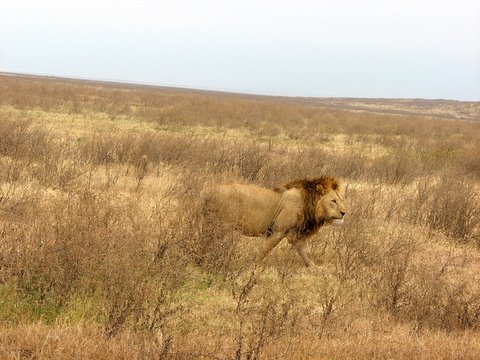 Huruma told us that the other male could possibly be this one's brother.
In the distance, we also saw some lionesses lying in the long grass...
Huruma told us that the other male could possibly be this one's brother.
In the distance, we also saw some lionesses lying in the long grass...
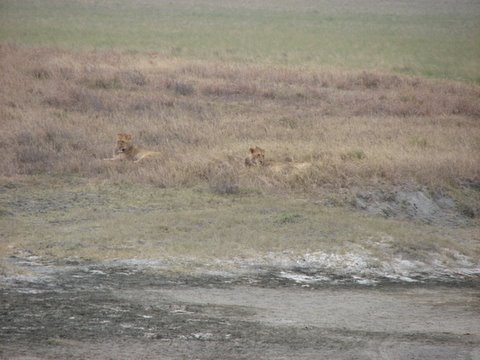 It was incredible how we would spot them only when they moved...as they lay down, they would just melt into the landscape and we would not know where to look, with many of us yelling, "where? where?" in desperation!
Still awed by this Walk Amongst Us, we went on to the OLDUVAI GORGE, where the Leakeys made the fossil discoveries of the earliest hominids, Homo erectus and Homo habilis....and the fossil footprints of three of these ancestors of ours walking on two legs, preserved for all time in the petrified volcanic ash. Here's part of the Olduvai Gorge, which is named after "Oldupai" which is the Swahiili for the WILD SISAL...
It was incredible how we would spot them only when they moved...as they lay down, they would just melt into the landscape and we would not know where to look, with many of us yelling, "where? where?" in desperation!
Still awed by this Walk Amongst Us, we went on to the OLDUVAI GORGE, where the Leakeys made the fossil discoveries of the earliest hominids, Homo erectus and Homo habilis....and the fossil footprints of three of these ancestors of ours walking on two legs, preserved for all time in the petrified volcanic ash. Here's part of the Olduvai Gorge, which is named after "Oldupai" which is the Swahiili for the WILD SISAL...
 and as we went on, we found yet another lioness, using just the banks of mud and grass as shade in the treeless plain...
and as we went on, we found yet another lioness, using just the banks of mud and grass as shade in the treeless plain...
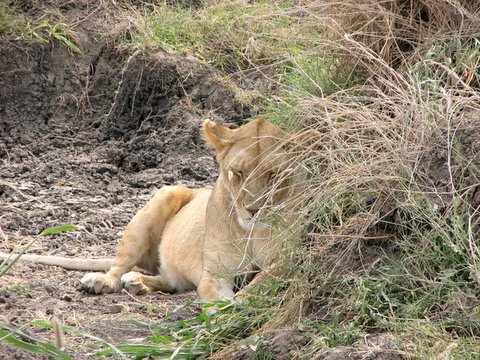 We then saw some TOPI
We then saw some TOPI
 and some MAGPIE SHRIKES in the thorny bushes..
and some MAGPIE SHRIKES in the thorny bushes..
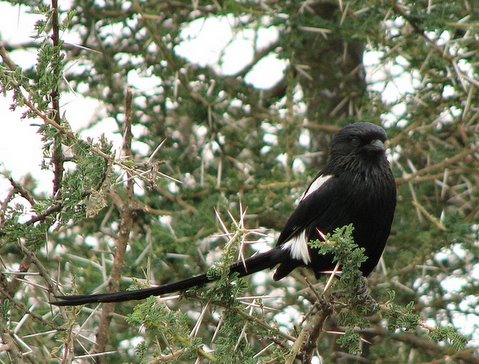 A little later, this is what we saw at a distance:
A little later, this is what we saw at a distance:
 The excitement of seeing that didn't prevent me from clicking the sOCIABLE WEAVER, which we found in large groups everywhere:
The excitement of seeing that didn't prevent me from clicking the sOCIABLE WEAVER, which we found in large groups everywhere:
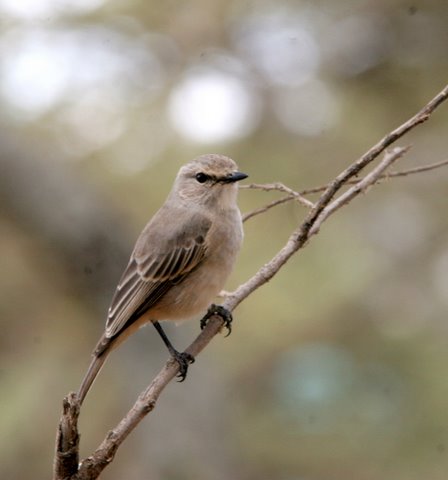 We also saw plenty of these dried flowers called "LION'S PAWS" because of their shape:
We also saw plenty of these dried flowers called "LION'S PAWS" because of their shape:
 In the evening, we had another wonderful incident. We came across a buffalo that had been killed by two lionesses, on the river bed:
In the evening, we had another wonderful incident. We came across a buffalo that had been killed by two lionesses, on the river bed:
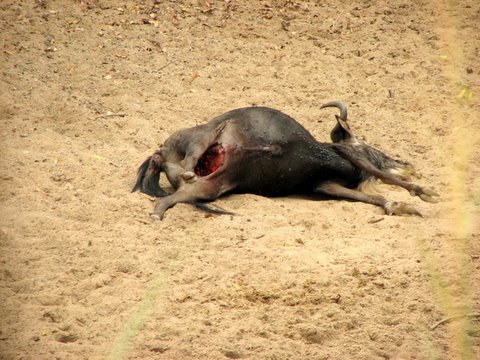 Huruma started looking for the lionesses...and then quietly pointed to the left of our vehicle. Can you see her?
Huruma started looking for the lionesses...and then quietly pointed to the left of our vehicle. Can you see her?
 The other lioness was circling around the riverbed. It seems that lions cannot feed immediatly after the kill; while running in the chase,their bodies overheat, and they must wait for about 45 minutes for their body temperature to come to normal.
During this period, a herd of baboons arrived to roost for the night in the nearby tree; and since they didn't want any predators around at night, they were preventing, by making loud noises, the lionesses from getting to the kill.
We waited a while to see if anything happened, but we had to be at the gate of the park before 6.30pm, so we had to leave....
</lj-cut>
Here's the first sunset we saw in the Serengeti:
The other lioness was circling around the riverbed. It seems that lions cannot feed immediatly after the kill; while running in the chase,their bodies overheat, and they must wait for about 45 minutes for their body temperature to come to normal.
During this period, a herd of baboons arrived to roost for the night in the nearby tree; and since they didn't want any predators around at night, they were preventing, by making loud noises, the lionesses from getting to the kill.
We waited a while to see if anything happened, but we had to be at the gate of the park before 6.30pm, so we had to leave....
</lj-cut>
Here's the first sunset we saw in the Serengeti:
 I'm sure those who went through the post will agree with me...that was one of the most eventful days that could happen on a wildlife safari!
I'm sure those who went through the post will agree with me...that was one of the most eventful days that could happen on a wildlife safari!


